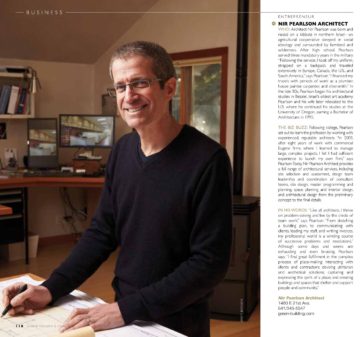WHO: Architect Nir Pearlson was born and raised on a kibbutz in northern Israel—an agricultural cooperative steeped in social ideology and surrounded by farmland and wilderness. After high school, Pearlson served three mandatory years in the military. “Following the service, I took off my uniform, strapped on a backpack, and traveled extensively in Europe, Canada, the U.S., and South America,” says Pearlson. “I financed my travels with periods of work as a plumber, house painter, carpenter, and silversmith.” In the late ‘80s, Pearlson began his architectural studies in Bezalel, Israel’s oldest art academy. Pearlson and his wife later relocated to the U.S. where he continued his studies at the University of Oregon, earning a Bachelor of Architecture in 1995.
THE BIZ BUZZ: Following college, Pearlson set out to learn the profession by working with experienced, reputable architects. “In 2003, after eight years of work with commercial Eugene firms where I learned to manage large, complex projects, I felt I had sufficient experience to launch my own firm,” says Pearlson. Today, Nir Pearlson Architect provides a full range of architectural services, including site selection and assessment, design team leadership and coordination of consultant teams, site design, master programming and planning, space planning and interior design, and architectural design from the preliminary concept to the final details.
IN HIS WORDS: “Like all architects, I thrive on problem-solving and live by the credo of team work,” says Pearlson. “From sketching a building plan, to communicating with clients, leading my staff, and writing invoices, my professional world is a winding course of successive problems and resolutions.” Although some days and weeks are exhausting and even bruising, Pearlson says, “I find great fulfillment in the complex process of place-making: interacting with clients and contractors; devising utilitarian and aesthetical solutions; capturing and expressing the spirit of a place; and creating buildings and spaces that shelter and support people and community.”

